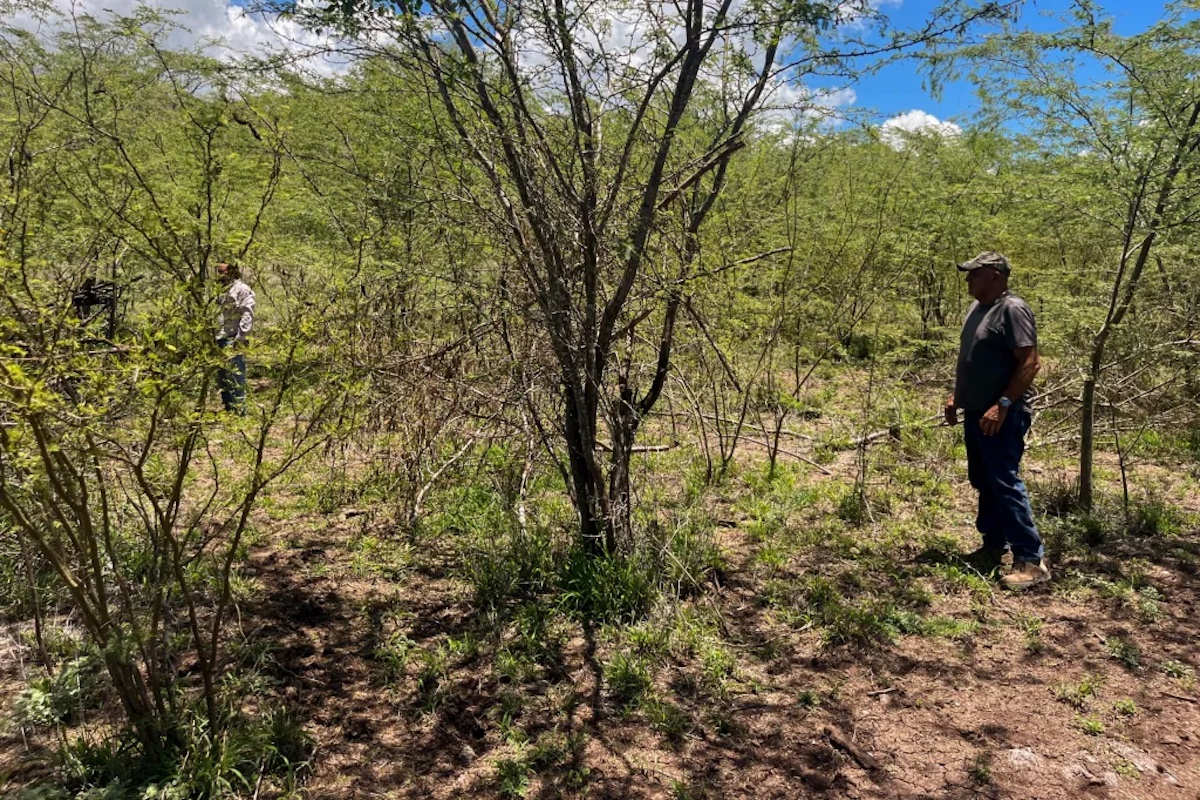

Carlos Montalvo Jr (left) and Carlos Montalvo Sr. (right) try to funnel cows back into their ranch to bathe them. (Photo by Carlos Edill Berríos Polanco)
By ELESHA GEORGE, CARLOS EDILL BERRÍOS POLANCO and JASON PINAS
Climate change has had significant effects on livestock in the Caribbean region.
As we’ve seen, livestock farmers in Antigua and Barbuda are facing challenges as drought conditions persist, leading to downsizing of their operations. Insufficient rain caused by climate change is driving up temperatures and drying up water sources, making it difficult to produce enough feed for the animals. Meanwhile, Puerto Rico’s transition from an agricultural society to an industrialized one has resulted in a significant decrease in the number of farms and farming land. Despite the tough conditions, livestock farmers remain undeterred. Similar concerns are echoed by livestock farmers in Suriname, a state highly sensitive to climate change and natural disasters.
In this article, journalists and Climate Tracker fellows Elesha George of Antigua and Barbuda, Carlos Edill Berríos Polanco of Puerto Rico and Jason Pinas of Suriname share the challenges their respective countries are facing in the battle against the effects of climate change on livestock.
***
Livestock Farmers in Antigua Downsizing As Drought Conditions Persist
by Elesha George
Livestock provides us with a source of food that is easily accessible and ordinarily low-cost to produce, but the practicality of rearing livestock for farmers in Antigua and Barbuda is gradually becoming out of reach with every year that there is insufficient rain.
Climate change is driving up temperatures and prolonging drought conditions in countries such as Antigua and Barbuda, which for over a decade has experienced severe drought, drying up the surface and groundwater catchments. Since there is not enough moisture from the rains to support the production of feed needed to sustain these animals locally, the cost of operation increases. Livestock farmer Sherwin Parker has known the ways of farming since he was a child. From his 30-plus years of experience, Parker says that more needs to be done for farmers in Antigua who are forced to reduce their stock numbers and endure higher operational costs.
“We are presently going through a prolonged drought, which hampers the animals’ growth and development a lot. During the rainy season, when we have a lot of grass, the animals are nice and round, but when the rain eases up, we have less food growth and less weight.”
Parker hasn’t had to truck in any food so far this year, but last year, he had to transport feed each day to the paddock where he keeps his cows and a few horses. “I’ve also had to reduce the number of animals in the paddock significantly because of a lack of food,” he stated.
In the absence of rainfall, there is a lack of water to replenish the pond on his land. He is compelled to travel a distance of two to five miles each day to obtain water and fill up the pond. “It was completely dry for almost a year and a half; I had to truck the water in. I normally bring in about five drums a day, every day,” he said.
According to Parker, it is an additional cost for fuel and equipment that he uses to pump the water. So, Parker was quite happy that his pond had filled after a heavy downpour two months ago. Unfortunately, that water has been rapidly evaporating because of the continued dry weather conditions and sporadic heat waves since 2023 began.
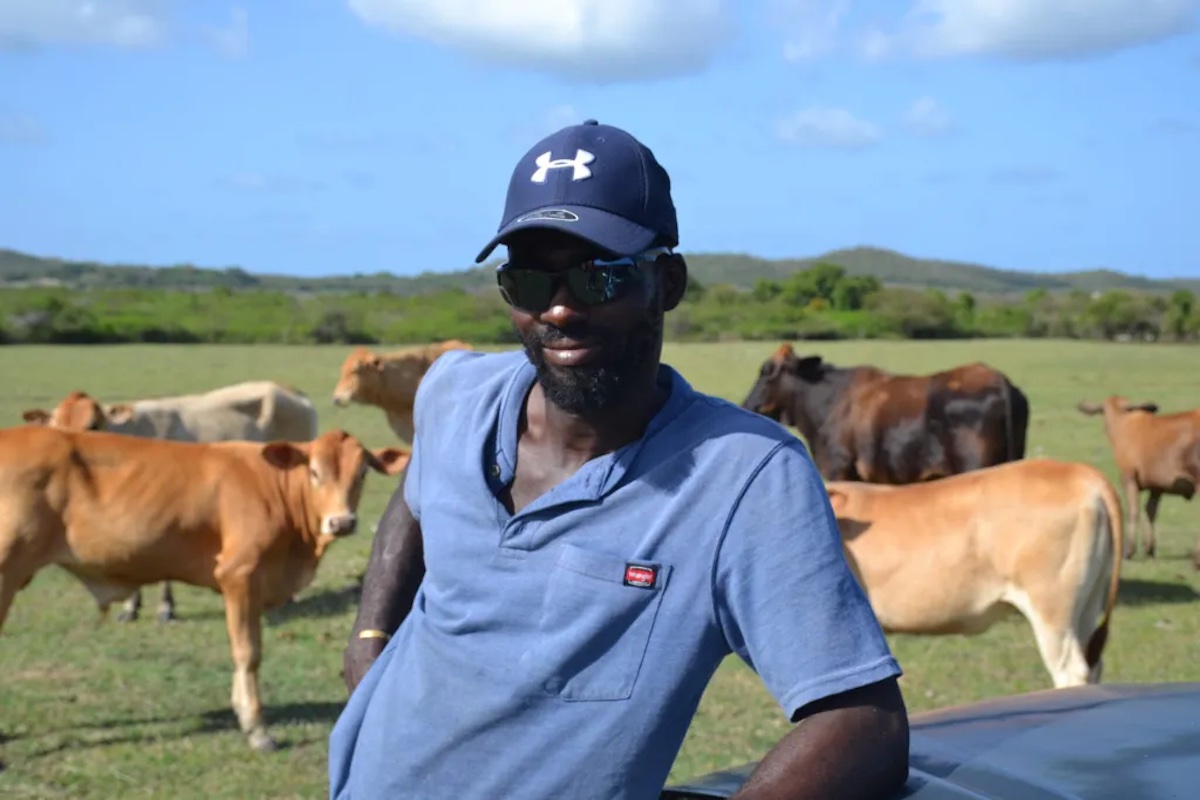

Sherwin Parker (Photo by Elesha George)
In April, the same month that local climatologist Dale Destin noted as the wettest April in a decade, the Antigua and Barbuda Meteorological Services —which Destin heads— issued an excessive heat wave advisory over five days. Temperatures rose between 38 and 41 °C, or 100 and 106 °F. Temperatures will continue to increase until October, which has been pegged as the “hot season.” In addition, Destin forecasts that Antigua will experience a 74 percent chance of below or near-normal rainfall for 2023 and notes that it would be very unlikely that the twin island state will see a wetter-than-normal year.
Camara Smith owns a pig farm and has had his share of concerns with the heat. It is not only reducing the amount of natural feed that is available to his pigs, but it is so hot that even the water he trucks in each month evaporates from the storage tanks.
“On this eastern side, it hardly gets rain. When we get rain, it has to be an islandwide rain to get rain.”
When the weather gets really dry, it costs Smith $300 to truck water to his farm each month. The lack of water also agitates the animals and causes them to breach their pens and attack the other pigs. At his old farm, Smith reared 300 pigs and had access to water, but in this new area, he can only house less than a dozen pigs. His decision to move his pen was prompted by praedial larceny, which many farmers in Antigua must contend with.
Nonetheless, Smith continues to invest in livestock farming, not because it is cheap, but because, as he said, “It’s costly, but it’s something that I like, and I enjoy it.”
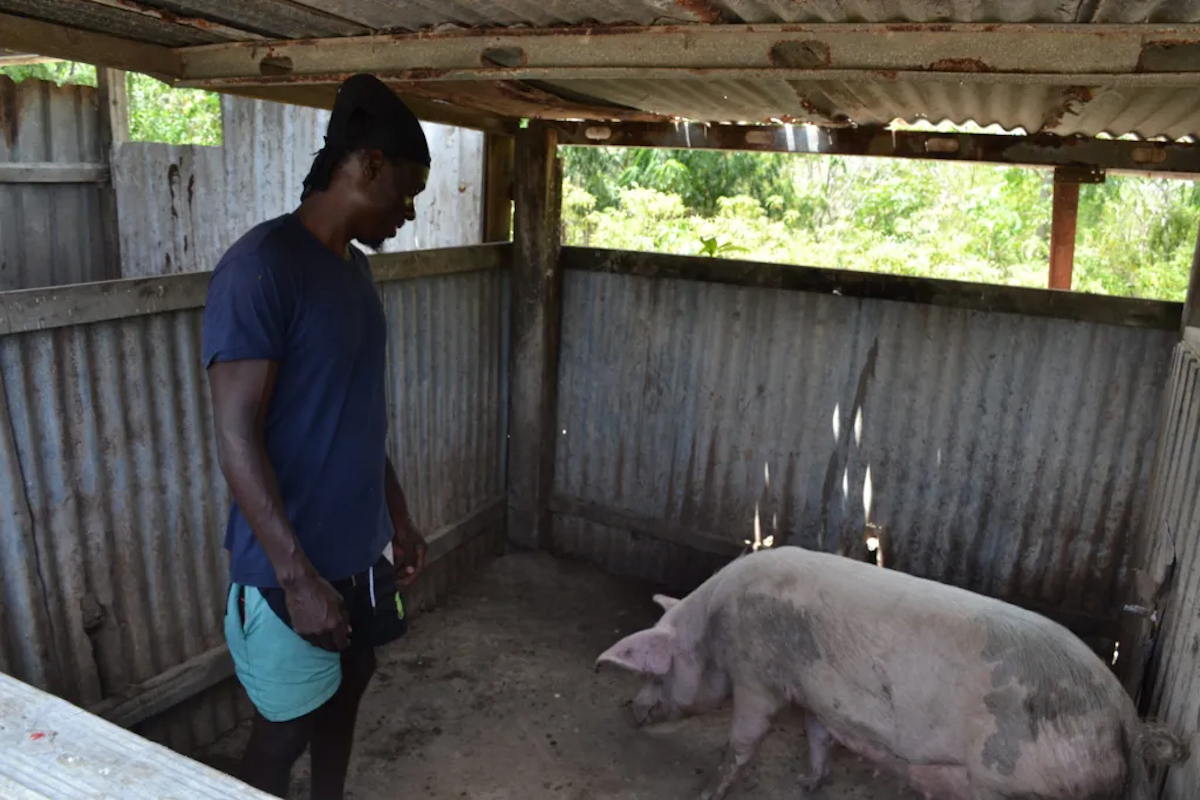

Camara Smith tends to a pig (Photo by Elesha George)
A bag of pig feed can cost the farmer as much as $68 a day, depending on where it is purchased—that’s upwards of $400 each week.
At the height of the pandemic, Stanford Mings, the owner of S&J Farm, recalled that it was costly to bring water to his chicken farm. He said two shipments of water cost him over $500 at a time when eggs were not selling as quickly.
“I sell a lot of eggs to Jolly Beach, and Jolly Beach was in the first set. I mean, all the hotels closed around the same time,” he recalled. “Normally you can break even or make a profit, but now it’s taking up all of my resources.”
The fact is that countries in the Eastern Caribbean region like Antigua and Barbuda are particularly vulnerable to the impacts of climate change, which can present itself in various forms, including drought and intensified weather systems. These impacts are aided by countries that continue to burn fossil fuels. The burning of fossil fuels has been blamed for global warming as they release carbon dioxide and other greenhouse gasses, which in turn trap heat in our atmosphere. They produce heat waves like those currently experienced in Antigua and Barbuda, which will continue to reduce air quality, worsen drought conditions and stagnate food for livestock if the most powerful world leaders do not demand change. The mass emitters must grant small states access to resources and help local leaders devise policies that can save these animals and, by extension, the livelihoods of thousands of people as well as the country’s economy.
***
Rancher in Puerto Rico Adapts to Climate Change Challenges, Explores Diverse Strategies for Survival
by Carlos Edill Berríos Polanco
“The animals eat faster than the grass grows,” Carlos Montalvo Jr. says as we jostle around in his big red truck through his nearly 200-acre ranch in late April.
While he only bought the farm in 2021, Montalvo already has 80 heads of cattle and big plans to expand his operation into selling the cows for meat. The Rancho Río Bravo is dotted with alternating spots of bright green and dry brown because it rained recently. Before a recent spate of rains, the entire ranch was the same sunburned brown color. Before Puerto Rico changed from an agricultural society to an industrialized one, raising cattle was one of the biggest businesses around. Plaza Las Américas, the largest shopping mall in the Caribbean, was built on an old dairy farm.
From 2012 to 2018, there was a nearly 38 percent reduction in the number of farms and an over 16 percent decrease in the amount of land used for farming.
Farming is in a tough spot in Puerto Rico, but Montalvo is undeterred, even though he’s faced his own set of struggles since opening his ranch. A worsening forest fire season led to a fire tearing through his farm the first year he bought it. His second and third years have been marked by bad droughts. In early April, nearly three-quarters of Puerto Rico were experiencing drought.
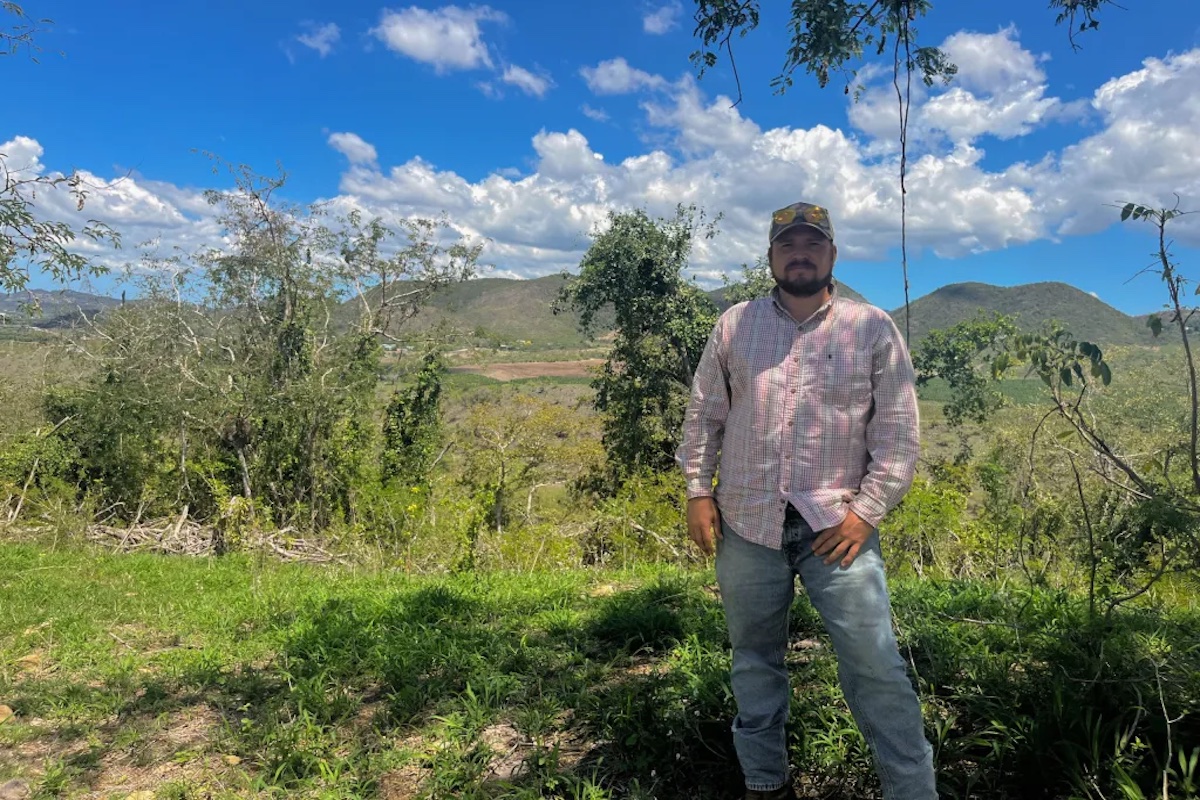

Carlos Montalvo Jr. stands at the edge of his ranch. (Photo by Carlos Edill Berríos Polanco)
“We get the extremes,” Carlos Montalvo Sr. said while keeping an eye on a herd of cows. He explains that in the over 40 years he’s been in and around the business of raising cattle, it went from raining two or three times a week to barely any precipitation in a month.
While more destructive hurricanes are the most noticeable effect of climate change in Puerto Rico, the drought has had the most effect on the ranch because the cows don’t have any grass to feed on. Montalvo Jr. is considering buying expensive feed to get him through times when the farm is dry but that’s another cost to add on top of an already expensive operation.
Climate change has had adverse effects on both livestock and the farms that house them. Droughts and high heat could potentially lead to premature deaths, decreased water availability and overgrazing. Dealing with potentially worse droughts in the future has been a prominent concern for Montalvo Jr, which is why he wants to put in an irrigation system to mitigate drought. He is also planning to work in new technologies, like solar panels and genetic testing, to strengthen the ability of his farm and his cattle to live through the worsening effects of climate change. Montalvo’s also invested exclusively in Senepol cows, a special breed of cows bred in St. Croix’s meant to resist the tropics.
Adapting to climate change is essential for ranches as the planet gets hotter, and adapting through a diversity of tactics is the most likely way to survive worsening droughts and hurricane seasons, although it comes at a cost to small and medium farms.
***
Surinamese Livestock Farmers Demand Government Action to Protect Against Climate Change Impacts
by Jason Pinas
The consequences of climate change can also be very serious for Suriname. According to the “Report State of the Climate in Suriname” produced by the Inter-American Development Bank (IDB), the country faces unmistakable challenges that threaten its special character. As a low-lying coastal state, Suriname is very sensitive to natural disasters and climate change.
Estimates suggest that a one-meter rise in sea level would affect more than 6.4 percent of Suriname’s GDP, 7 percent of its population and 5.6 percent of its agricultural land. Ignoring this reality can lead to serious human and economic casualties, the report said.
“I hold my heart for the future. Climate change is a fact, so we need to be prepared for it. But exactly how we should approach it in order not to suffer major damage remains the big question,” livestock farmer Reinier Ramond said in a serious tone. He believes that the Surinamese government should provide more information in this area.
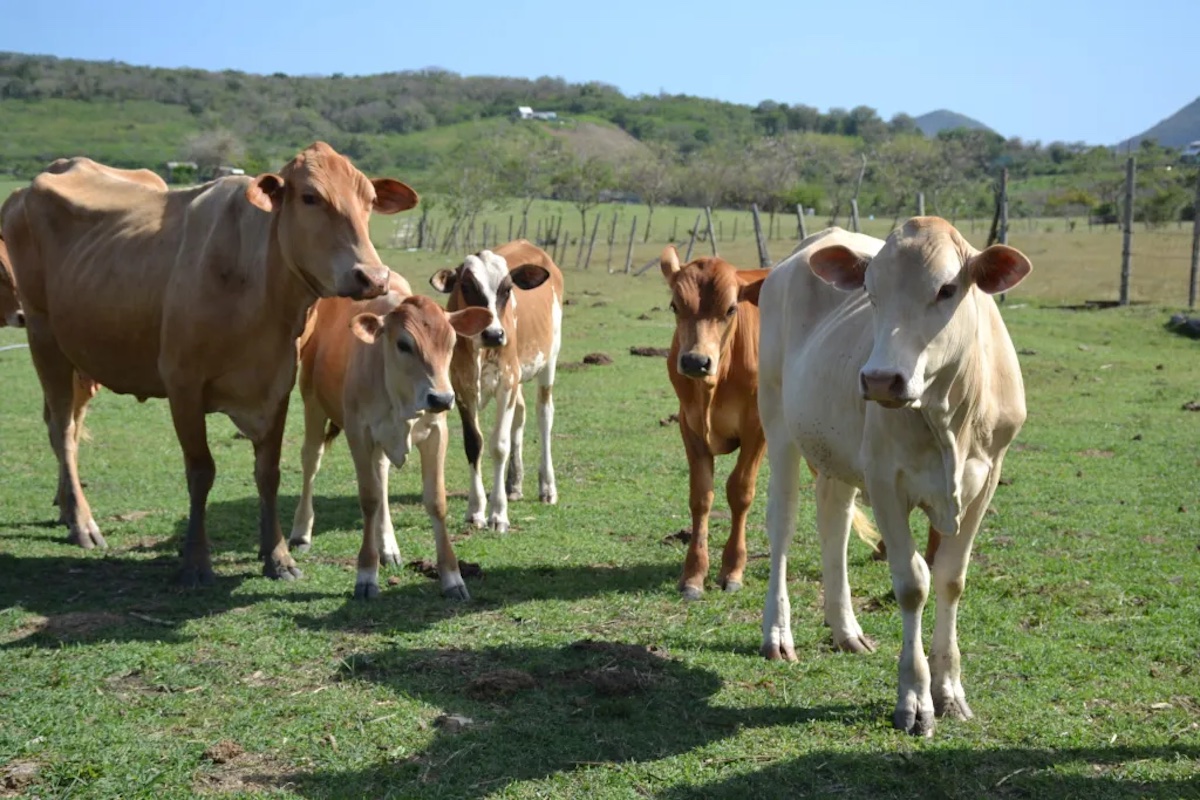

Cows gather at Reinier Ramond’s farm (Photo by Jason Pinas)
“I don’t know what the government’s plans are. I think they should protect us from the consequences. This can already be done through good communication, but I have not noticed much of this so far,” Ramond continued. He does not have a large farm but fears a huge loss if a major flood were to come. “When it rains constantly for a few days, I already have a problem. So if there’s a flood, I won’t be spared,” Ramond added.
He points out that chicken, pork, and beef are imported, but the local livestock farmers provide a large part of the local market.
They also export to the Caribbean and other parts of the world, which means money for the government.
“We underestimate it. But if the livestock farmers get into trouble, it will certainly have consequences for the community and the Surinamese economy. Do you know how many people eat Surinamese chicken every day?” Ramond noted. “I think it would be good if the government started a special fund to support livestock farmers who will be in trouble in the future due to the effects of climate change. Otherwise, we’re all going to have to slowly close our doors.”
On several occasions, President Chandrikapersad Santokhi has underlined the serious consequences that climate change can have for multiple sectors. For example, the interior and other parts of the coastal area have experienced major flooding several times. However, concrete actions by the government to minimize losses for entrepreneurs have so far not materialized.
“We are entrepreneurs. We continue to sound the alarm. But we cannot do more than that. We can’t take over the work of the government,” Ramond said.
***
Summary
To effectively address the challenges faced by livestock farmers due to climate change and drought conditions, most agree that a comprehensive approach is needed. Governments should step in and provide support to farmers. This can be done through the implementation of policies and initiatives aimed at mitigating the impacts of climate change on agriculture, such as the following:
- Allocate funding and resources to assist farmers in adapting to changing climatic conditions. This can include establishing special funds to provide financial assistance to farmers affected by climate change, offering subsidies for feed and water expenses, and implementing agricultural assistance programs that provide technical support and guidance.
- Prioritize effective communication and information dissemination to farmers, ensuring they have access to up-to-date and relevant information on climate change and its impacts on their livelihoods.
By taking these measures, governments can play a crucial role in supporting livestock farmers and safeguarding the agricultural sector against the adverse effects of climate change.
***
This story was published with the support of the Caribbean Climate Justice Journalism Fellowship, which is a joint venture of Climate Tracker and Open Society Foundations.



[…] Reports from Antigua & Barbuda refer to an inability to produce feed for livestock due to insufficient precipitation, while the Jamaican Agricultural Society has reported that many small poultry farmers have recorded significant losses, raising an alarm for a potential chicken shortage for the Christmas season. […]
[…] Reports from Antigua & Barbuda refer to an inability to produce feed for livestock due to insufficient precipitation, while the Jamaican Agricultural Society has reported that many small poultry farmers have recorded significant losses, raising an alarm for a potential chicken shortage for the Christmas season. […]
[…] Reports from Antigua & Barbuda refer to an inability to produce feed for livestock due to insufficient precipitation, while the Jamaican Agricultural Society has reported that many small poultry farmers have recorded significant losses, raising an alarm for a potential chicken shortage for the Christmas season. […]
[…] Reports from Antigua & Barbuda refer to an inability to produce feed for livestock due to insufficient precipitation, while the Jamaican Agricultural Society has reported that many small poultry farmers have recorded significant losses, raising an alarm for a potential chicken shortage for the Christmas season. […]
[…] Reports from Antigua & Barbuda refer to an inability to produce feed for livestock due to insufficient precipitation, while the Jamaican Agricultural Society has reported that many small poultry farmers have recorded significant losses, raising an alarm for a potential chicken shortage for the Christmas season. […]